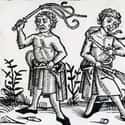-

(#13) Plague Doctors Were Probably Pretty Lonely
Plague doctors were necessarily separated from the rest of the population of a town or village where they were tending to patients. This was to protect the doctor as well as the healthy citizens alike. Giovanni de Ventura, according to his contract, was only allowed to move about the city when he was accompanied by an escort, unless he was seeing patients.
After a period of serving as a plague doctor, the physician would then spend at least 40 days in isolation; however, generally speaking, plague doctors lived their lives under quarantine due more to social stigma than anything else.
-
(#11) Plague Doctors Served As Record Keepers and Record Watchers
One of the most beneficial contributions made by plague doctors was the sheer volume of detailed information they kept about their patients. Plague doctors kept registers of the number of victims for public record, documented people's last wishes, and often testified for and witnessed wills being sorted. Their service to the public went beyond just medical care.
-
(#3) Plague Masks Were All About Smelling The Roses
The infamous plague masks were actually associated with air purity. During the 17th and 18th centuries, the idea that the air could be polluted became widespread and doctors sought to prevent "bad air," or the miasma, from getting to them.
Eye holes were fitted with glass pieces so doctors could still see, and the long noses on the mask were filled with drugs and aromatic herbs, including mint, camphor, cloves, straw, laudanum, rose petals, and myrrh to filter the air. The herbs also helped with the smell, considering that the dead bodies and lanced buboes that doctors dealt with were rather pungent.
However, despite rumors, 'Ring Around The Rosie' was most likely not about the plague.
-

(#9) When All Else Failed, People Found Scapegoats
When God throws down a scourge, the tendency is to try to find a reason - and someone to blame. Christians tried to identify Jews as the cause of the disease - although Pope Clement VI issued a statement saying that it wasn't their fault. However, this didn't stop people from looking for a scapegoat.
Pope Clement VI even famously surrounded himself with fire to keep the evil of the plague from infecting him, but it was actually the heat itself that kept him safe, not the fire warding off evil spirits.
-

(#5) Plague Doctors Treated Everyone Because Everyone Got The Plague
Wealth certainly offers greater access to healthcare - that hasn’t changed much - but during the Middle Ages, plague doctors were hired by towns and villages to treat everyone. Since the location was paying them, not the individual, all sick people were provided with the same medical care.
For example, when Giovanni de Ventura served as a community plague doctor in Pavia in 1479, he received a monthly payment, a furnished house, local citizenship, and living expenses from the city. He didn't charge the patients, but could take payment from individuals if they offered.
-
(#8) Treatments Also Included Making God Happy
During the Middle Ages, the belief was that bad things happened because God was dissatisfied with humanity. This meant that people needed to make amends. As a result, self-flagellation became a common treatment for the plague. Individuals would whip themselves in order to atone for whatever sins had brought about the disease.
In fact, there were entire groups of flagellants dedicated to the practice. But, when a person couldn't whip themselves sufficiently or were already sick and too weak, they often asked the plague doctors to do it for them.
New Random Displays Display All By Ranking
About This Tool
In the Middle Ages, the Black Death was spread around Europe. In order to prevent infection, plague doctors wore waxed linen or canvas shirts and a beak mask that could filter the air. For the treatment of the Black Death, the most popular treatment at that time was bloodletting. This mysterious medical treatment was the top medical technology, but because the blood was infectious, plague doctors became a high-risk population.
Most of the plague doctors in the Middle Ages in Europe were part-time by clerics. European people fled due to panic and could not effectively control the epidemic. The random tool explained 13 horrifying things about plague doctors.
Our data comes from Ranker, If you want to participate in the ranking of items displayed on this page, please click here.












